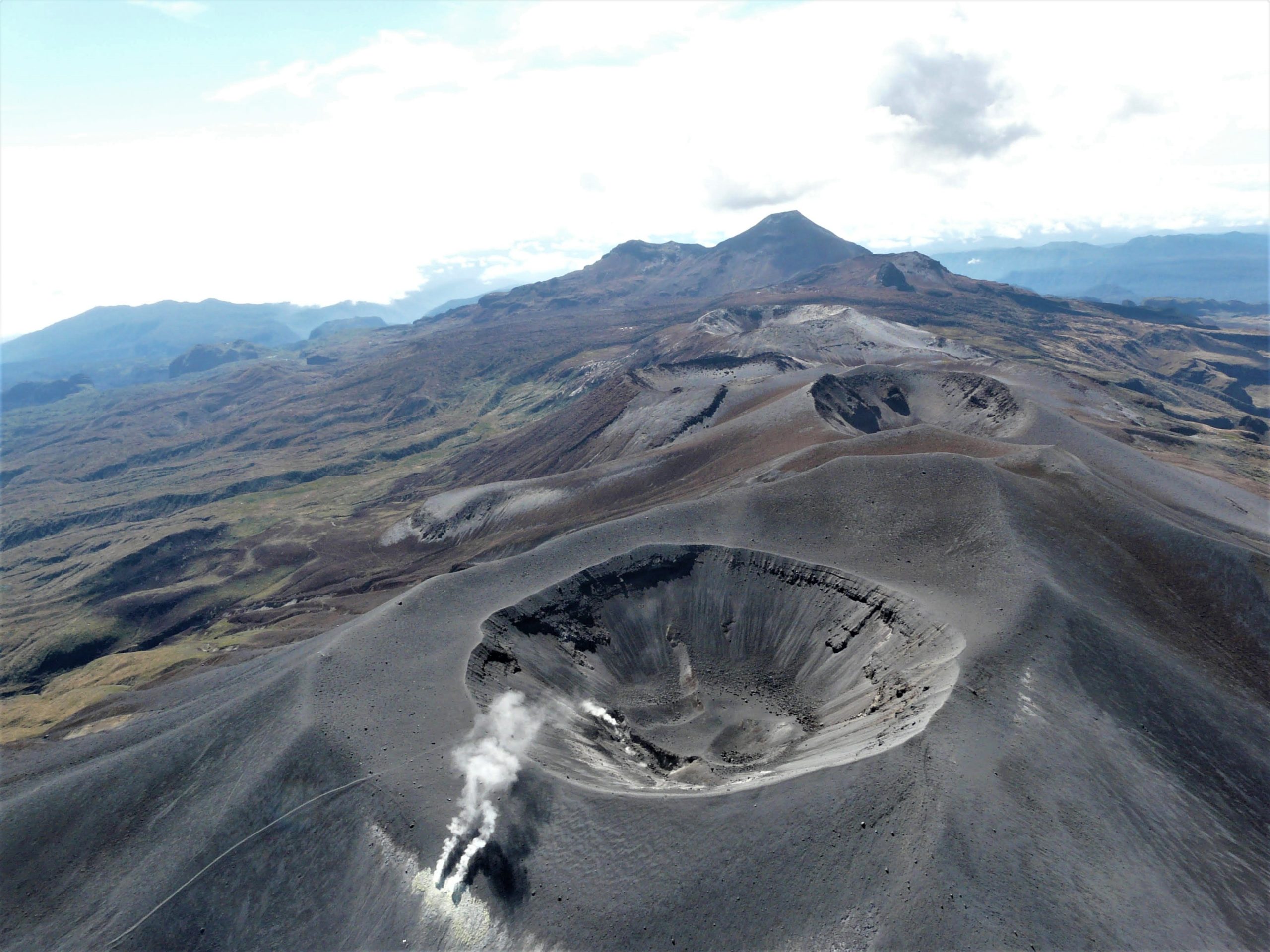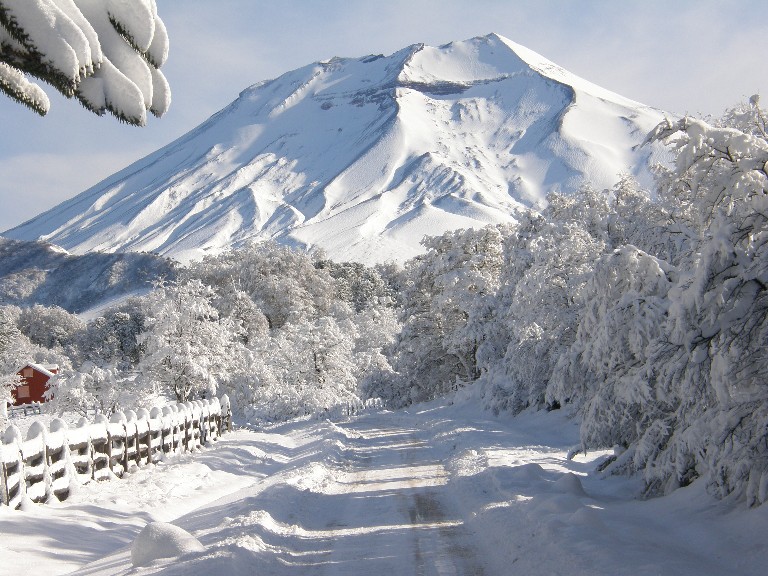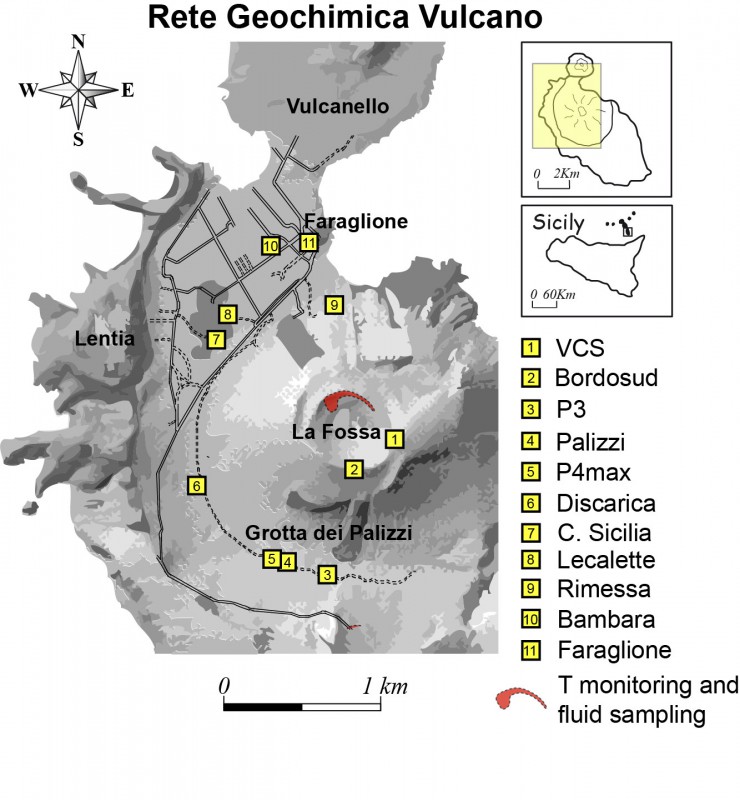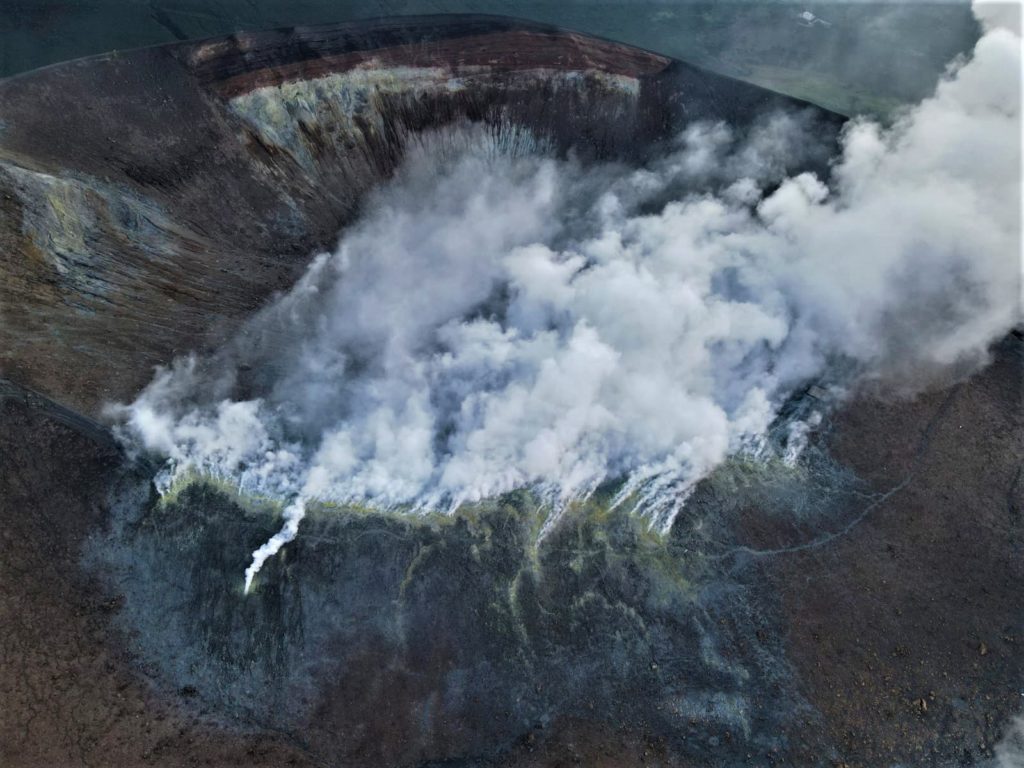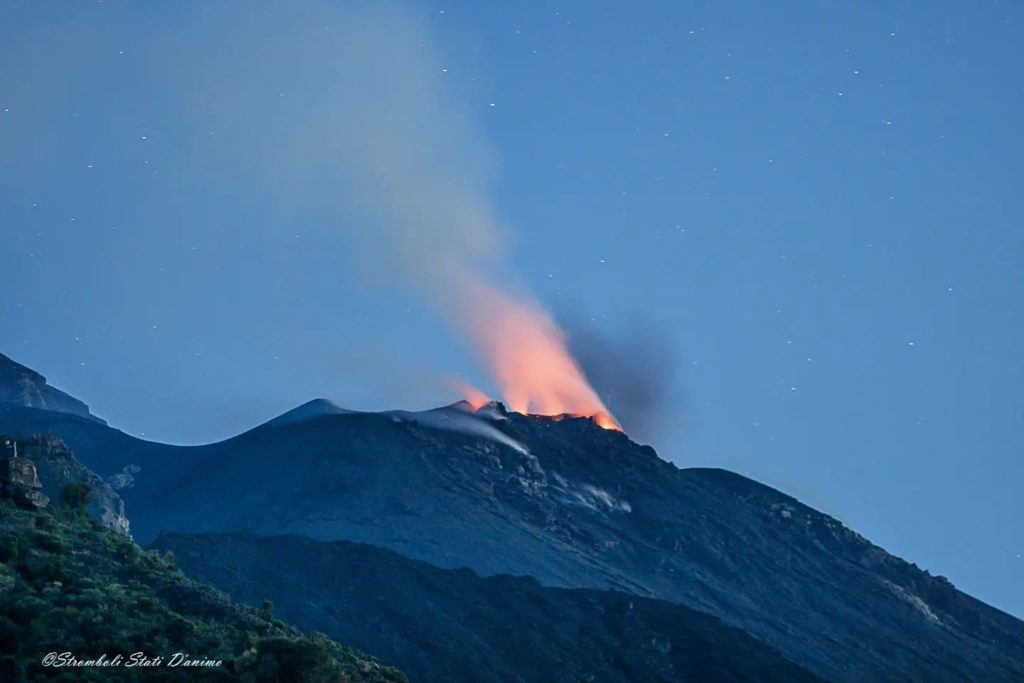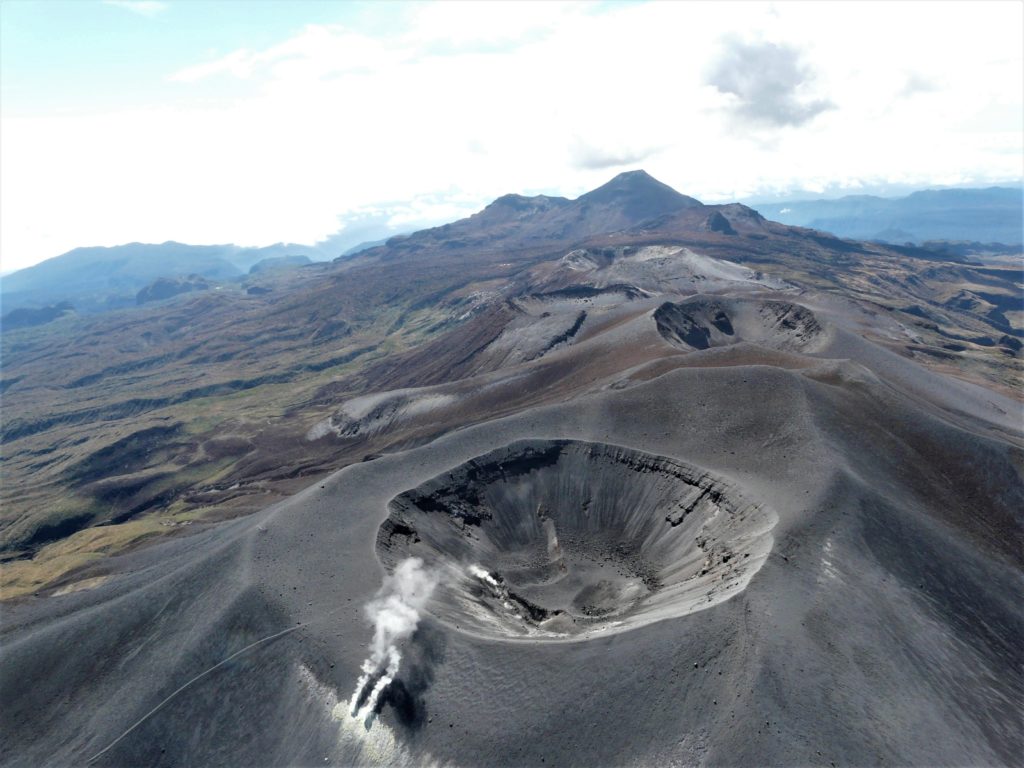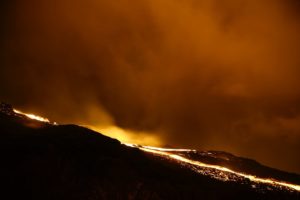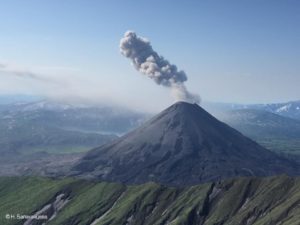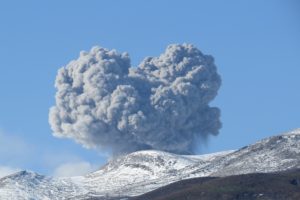April 2022.
Chile , Lonquimay :
Lonquimay Volcanic Complex
SEISMOLOGY
Seismic activity during the month was characterized by:
Twenty-six VT type seismic events associated with rock fracturing (Volcano-Tectonic type) were recorded. The most energetic earthquake presented a value of local magnitude (ML) equal to 1.5, located 3.0 km west-northwest of the volcanic edifice, at a depth of 10.6 km from the crater.
10 LP-type seismic events were recorded, associated with fluid dynamics within the volcanic system (Long Period type). The size of the largest earthquake assessed from the reduced displacement parameter (RD) was equal to 19.6 cm2.
Two TR-type seismic events were recorded, associated with sustained fluid dynamics within the volcanic system (Tremor). The size of the largest earthquake estimated from the reduced displacement parameter (RD) was equal to 3.3 cm2.
23 HB-type seismic events were recorded, associated with both rock fracturing and fluid dynamics within the volcanic system (Hybrid type). The most energetic earthquake presented a local magnitude value (ML) equal to 1.8, located 6.3 km east-northeast of the volcanic edifice, at a depth of 9.8 km from the crater.
FLUID GEOCHEMISTRY
No anomalies were reported in the emissions of sulfur dioxide (SO2) into the atmosphere in the area near the volcanic edifice, according to data published by the Tropospheric Monitoring Instrument. (TROPOMI) and the Ozone Monitoring Instrument (OMI) Sulfur Dioxide Group (http://so2.gsfc.nasa.gov/).
SATELLITE THERMAL ANOMALIES
During the period, no thermal alert was recorded in the area associated with the volcanic edifice, according to data processed by the Mid-Infrared Observation of Volcanic Activity (MIROVA) (http:// www.mirovaweb.it/) and by the analysis and processing of Sentinel 2-L2A satellite images, in combination with false color bands.
GEODESY
According to the data provided by 2 GNSS stations and the analysis carried out using radar interferometry, no variation was observed indicating changes in the internal dynamics of the volcano during the period evaluated.
SURVEILLANCE CAMERAS
The images provided by the fixed camera installed near the volcano did not record degassing columns on the volcano or variations related to surface activity.
GEOMORPHOLOGICAL SATELLITE ANALYSIS
Thanks to the monitoring of surface activity carried out from Planet Scope and Sentinel 2-L2A satellite images from March, no morphological changes are identified in the crater of the Lonquimay volcano or in the minor emission centers. located on the sides. There are also no emissions of recent volcanic materials.
Activity remained at levels considered low, suggesting stability of the volcanic system. The volcanic technical alert is maintained at: YELLOW TECHNICAL ALERT: Changes in the behavior of volcanic activity
Source : Sernageomin.
Photo : Leonardo Araya / wikipedia.
Italy , Vulcano :
WEEKLY BULLETIN, April 04, 2022 to April 10, 2022. (issue date April 12, 2022)
ACTIVITY STATUS SUMMARY
In the light of the surveillance data, it is highlighted:
1) Temperature of the crater fumaroles: The temperature data recorded on the rim of the crater show stable values at high levels.
2) CO2 flux in the crater area: The latest measurements show high values of 12281 g m-2 d-1.
3) SO2 flux in the crater area: SO2 flux at a medium-high level and moderately increasing
4) Geochemistry of fumarolic gases: The last sampling confirmed the downward trend of magmatic species in fumarolic gases
5) CO2 fluxes at the base of the La Fossa cone and in the Vulcano Porto area: The CO2 fluxes recorded in the C. Sicilia and P4max sites continue to show a slight downward trend, but remain at values medium-high; in the Faraglione site, there are values close to the background level.
6) Geochemistry of thermal aquifers: The temperature measured in the Camping Sicilia well is at high and stable values. The electrical conductivity shows low values.
The level values measured in the Bambara well show a small fluctuation. Conductivity values remain constant at medium-high levels.
7) Local seismicity: low occurrence rate of local events.
8) Regional seismicity: Moderate fracturing seismicity associated with earthquakes with Ml >= 1.0.
9) Deformations – GNSS: The network of permanent GNSS stations has not recorded any significant changes.
10) Deformations – Inclinometry: The inclinometric network has not recorded any significant changes.
11) Other observations: Gravimetry: During the period considered, no significant variation was recorded
CRATER FUMEROLES TEMPERATURE:
The reference sensor for the maximum temperature has very stable values (T1: 382-387°C), with a weekly average of 385°C. Locally, the sensor placed in the fumarole of the embankment showed too much instability of the measurements which suggests the need for a complex and difficult maintenance intervention (verification of the measurements, replacement of the cable stretched along the embankment and replacement of the probe). . Until March 25, the heat flux recorded at the VSCS summit station was well above the pre-crisis background level range.
REGIONAL SEISMICITY:
In the week of April 4-10, 6 events of local magnitude greater than or equal to 1.0 (maximum Ml = 2.0) were recorded in the Vulcano Island area. In particular, on the 6th, the tremors occurred between 7:57 a.m. (UTC) on April 9 and 7:23 a.m. on April 10. On the 9th, there were two events of Ml equal to 1.3 and 1.2 located in the central part of the island (Zone Piano) with a depth between about 5 km and 7.5 km a.s.l. The other 4 events occurred on the 10th in just under an hour, have a local magnitude between M1.2 and M2.0 and are located east of the island of Vulcano at a depth between approximately 9 and 10 km.
Source : INGV.
Photos : INGV , INGV-Roma1
Italy , Stromboli :
WEEKLY BULLETIN, April 04, 2022 to April 10, 2022. (issue date April 12, 2022)
ACTIVITY STATUS SUMMARY
In the light of the surveillance data, it is highlighted:
1) VOLCANOLOGICAL OBSERVATIONS: During this period, normal explosive activity of the Strombolian type was observed with intense spattering activity in the N zone. The total hourly frequency of explosions oscillated between average values (15 events/h) and medium-high (19 events/h). The intensity of the explosions was mainly medium to low in both the North Crater area and the Center-South Crater area.
2) SEISMOLOGY: The seismological parameters monitored do not show any significant variations. NOTE: The bulletin is created with data acquired from up to 6 stations.
During the past week, no seismic signal associated with landslides has been recorded.
3) SOIL DEFORMATIONS: The island’s soil deformation monitoring networks did not show any significant variation.
4) GEOCHEMISTRY: SO2 flux at an average level CO2 fluxes in the crater area remain at medium-high values.
Due to technical issues, there are no updates on the C/S ratio in the plume.
High values of the isotopic ratio of Helium dissolved in heat sinks (R/Ra 4.36 05/04/2012)
5) SATELLITE OBSERVATIONS: The thermal activity observed by satellite was at a low level.
VOLCANOLOGICAL OBSERVATIONS
During the observation period, the eruptive activity of Stromboli was characterized through the analysis of images recorded by the INGV-OE surveillance cameras (altitude 190m, Punta Corvi, altitude 400m and Pizzo). The explosive activity was mainly produced by 5 (five) eruptive vents located in the North crater area and 2 (two) eruptive vents located in the Center-South crater area. All the mouths are located inside the depression which occupies the terrace of the crater.
Due to unfavorable weather conditions on April 7 and 10, 2022, the visibility of the crater terrace was insufficient for a correct description of the eruptive activity.
Sector N1 located in the area of the North crater produced explosions of variable intensity, from low (less than 80 m high) to medium (less than 150 m high) emitting coarse materials (lapilli and bombs). Sector N2, with four emission points, showed explosive activity of medium-low intensity (less than 120 m in height) emitting coarse materials with intense projection activity during long intervals on April 8 and 9. The average frequency of explosions varied from 11 to 15 events/h.
In the Center-South zone, sectors C and S1 did not show significant explosive activity. Sector S2, with two emission points, had explosions of medium to low intensity (the products of the explosions often exceeded 80 m in height) emitting coarse materials. The frequency of explosions was almost constant with 4-5 events / h.
Source : INGV.
Photo : Stromboli stati d’animo
Colombia , Nevado del Ruiz :
Bulletin of activity level of the Nevado del Ruiz volcano.
The activity level continues at Yellow Activity Level or (III): changes in the behavior of volcanic activity.
Regarding the monitoring of the activity of the Nevado del Ruiz volcano, the COLOMBIAN GEOLOGICAL SERVICE reports that:
The seismicity associated with rock fracturing has slightly decreased in number of earthquakes and seismic energy released, compared to the previous week. This seismic activity was located mainly in the Arenas crater and in the South-South-West and South-South-East sectors of the volcano. The depth of the earthquakes varied between 0.5 and 5.8 km. The maximum magnitude recorded during the week was 0.76 ML (Local Magnitude), corresponding to the earthquake that occurred on April 11 at 11:16 p.m. (local time), located 0.6 km southeast of the Arenas crater, at a depth of 2.43 km.
Seismicity related to fluid dynamics inside volcanic conduits increased in number of earthquakes and seismic energy released, compared to the previous week. This seismic activity was characterized by the appearance of continuous volcanic tremors, TC type, tremor pulses, TR type, long period earthquakes, LP type, and very long period earthquakes, VLP type. . In general, these signals exhibited low to moderate energy levels and variable spectral content. Most of these earthquakes were located in the Arenas crater. Some of them were associated with gas and ash emissions that have been confirmed by the cameras installed in the volcano area and by reports from officials of the Los Nevados National Natural Park and the Colombian Geological Service, in addition to visual appreciation in different places around the area of influence of the volcano. Likewise, changes in the relative temperature of the material emitted by the FLIR cameras (Thermal Cameras) of the SGC multi-parameter volcanic monitoring network have been observed. Among the signals associated with gas and ash emissions, those that occurred yesterday afternoon and today morning stand out, respectively at 5:13 p.m. and 8:58 a.m. local time. Corresponding to two multiple fluid events. Gas and ash emissions reached heights of 3,258 m. and 3194 m measured on the summit of the volcano, with dispersion yesterday afternoon towards the North and today in the morning towards the South-West of the Arenas crater.
Source : SGC.
Photo : Servicio Geológico Colombiano / El Nuevo Día.
Colombia , Puracé :
Weekly bulletin of the activity of the Puracé volcano – Los Coconucos volcanic chain.
The activity level of the volcano continues at the Yellow activity level or (III): changes in the behavior of volcanic activity.
From the analysis and evaluation of the information obtained through the monitoring network of the Puracé volcano – Los Coconucos volcanic chain, during the week of April 5 to 11, 2022, the COLOMBIAN GEOLOGICAL SERVICE – Volcanological and Seismological Observatory of Popayan reports that:
• During the evaluated period, 2,077 seismic events were recorded, of which 248 were related to rock fracturing processes (type VT) and 1,829 to fluid dynamics.
in volcanic conduits. Of these, 1,759 were classified as long-period events (LP type), 37 as low-energy tremor pulses (TR type), and 31 as
hybrid events (type HB).
• The geodetic network for measuring the deformation of the volcanic soil, as well as the processing of satellite images, continue to record a process associated with inflation of the millimeter order.
• Measurements of sulfur dioxide (SO2) gas emissions continued, reporting average values of around 1,800 t/day for this week.
Therefore, it is concluded that a significant increase in volcanic activity continues to be recorded, in accordance with the behavior expected at activity level III (yellow level), which could evolve towards states of greater activity. The Colombian Geological Service continues to monitor the evolution of the volcanic phenomenon and will report any changes that may occur in due course.
Source : SGC.
Photo : SGC
Iceland , Reykjanes Peninsula:
An earthquake swarm began yesterday evening located near the SW-ern tip of the Reykjanes Peninsula. The swarm began with an M3.9 earthquake and six other earthquakes with magnitude above 3.0 have been detected. Nearly 600 earthquakes have been detected since the swarm began. The swarm is still ongoing thoug the intensity of it has decreased. The IMO has received felt reports for the largest earthquakes from the Reykjanes peninsula and the Capital area. Last time an earthquake of similar magnitude was recorded in this area was in November 2021 when an M3.5 earthquake occurred there
The activity now is happening in a volcano named Reykjanes. Last eruption might have happened last time in the year 1831 but that is difficult to know for sure. At the writing of this article around 264 to 280 earthquakes have been recorded by Icelandic Met Office. This number changes every few minutes because the earthquake swarm is strong and ongoing currently. Earthquake activity seems to be increasing at the writing of this article. This situation can change quickly. I am seeing clues that this earthquake swarm is because of magma movement. I think it might result in a eruption, but that is impossible to know for sure now.
Source : Vedur is, icelandgeology.net.
Photo : Icelandic Met Office

